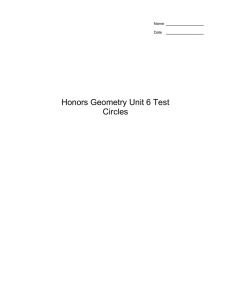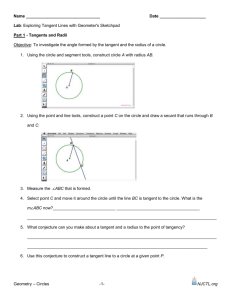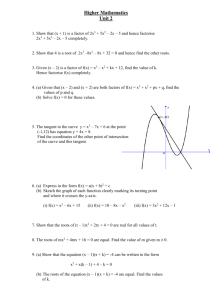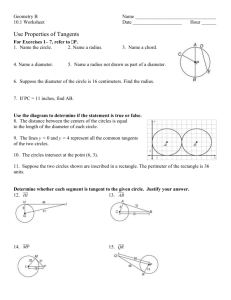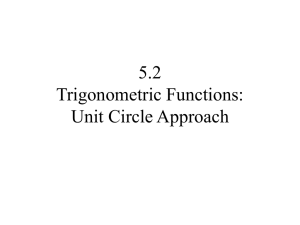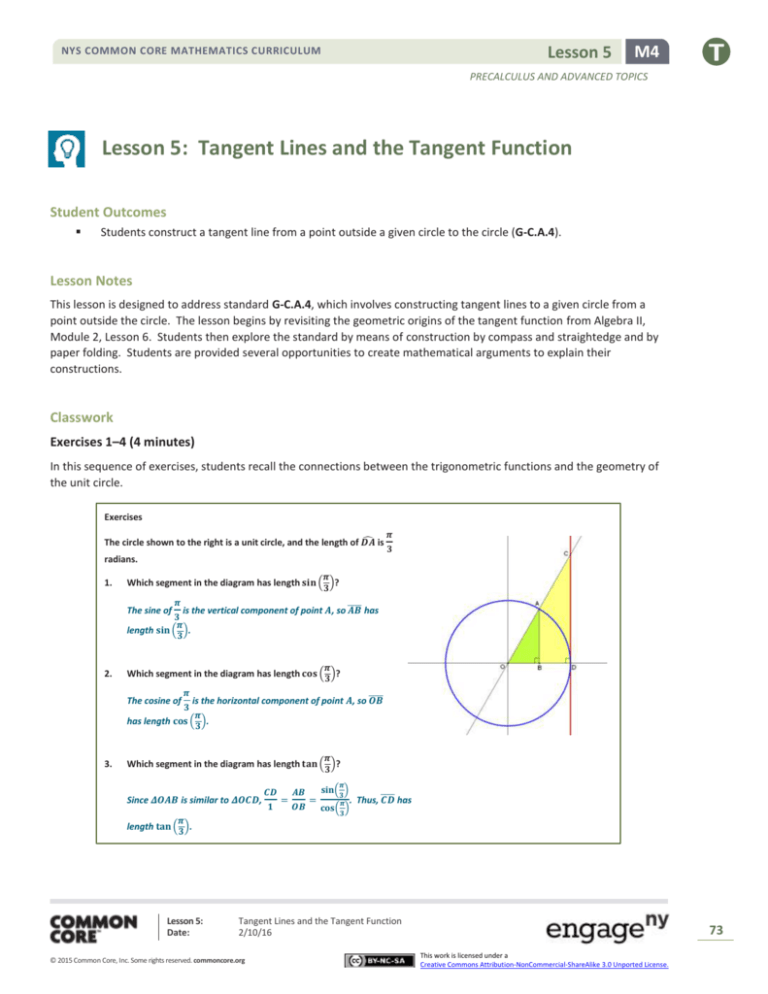
Lesson 5
NYS COMMON CORE MATHEMATICS CURRICULUM
M4
PRECALCULUS AND ADVANCED TOPICS
Lesson 5: Tangent Lines and the Tangent Function
Student Outcomes
Students construct a tangent line from a point outside a given circle to the circle (G-C.A.4).
Lesson Notes
This lesson is designed to address standard G-C.A.4, which involves constructing tangent lines to a given circle from a
point outside the circle. The lesson begins by revisiting the geometric origins of the tangent function from Algebra II,
Module 2, Lesson 6. Students then explore the standard by means of construction by compass and straightedge and by
paper folding. Students are provided several opportunities to create mathematical arguments to explain their
constructions.
Classwork
Exercises 1–4 (4 minutes)
In this sequence of exercises, students recall the connections between the trigonometric functions and the geometry of
the unit circle.
Exercises
̂ is
The circle shown to the right is a unit circle, and the length of 𝑫𝑨
𝝅
𝟑
radians.
1.
𝝅
𝟑
Which segment in the diagram has length 𝐬𝐢𝐧 ( )?
The sine of
𝝅
is the vertical component of point 𝑨, so ̅̅̅̅
𝑨𝑩 has
𝟑
𝝅
length 𝐬𝐢𝐧 ( ).
𝟑
2.
𝝅
𝟑
Which segment in the diagram has length 𝐜𝐨𝐬 ( )?
The cosine of
𝝅
𝟑
is the horizontal component of point 𝑨, so ̅̅̅̅̅
𝑶𝑩
𝝅
𝟑
has length 𝐜𝐨𝐬 ( ).
3.
𝝅
𝟑
Which segment in the diagram has length 𝐭𝐚𝐧 ( )?
Since 𝜟𝑶𝑨𝑩 is similar to 𝜟𝑶𝑪𝑫,
𝝅
𝟑
𝑪𝑫
𝟏
=
𝑨𝑩
𝑶𝑩
𝝅
𝟑
𝝅 .
𝐜𝐨𝐬( )
𝟑
𝐬𝐢𝐧( )
=
Thus, ̅̅̅̅
𝑪𝑫 has
length 𝐭𝐚𝐧 ( ).
Lesson 5:
Date:
Tangent Lines and the Tangent Function
2/10/16
© 2015 Common Core, Inc. Some rights reserved. commoncore.org
73
This work is licensed under a
Creative Commons Attribution-NonCommercial-ShareAlike 3.0 Unported License.
M4
Lesson 5
NYS COMMON CORE MATHEMATICS CURRICULUM
PRECALCULUS AND ADVANCED TOPICS
𝝅
𝟑
Which segment in the diagram has length 𝐬𝐞𝐜 ( )?
4.
Since 𝜟𝑶𝑨𝑩 is similar to 𝜟𝑶𝑪𝑫,
𝑶𝑫
𝑶𝑩
=
𝑶𝑪
. Since 𝑶𝑨 = 𝑶𝑫 = 𝟏 we have 𝑶𝑪 =
𝑶𝑨
𝝅
𝟑
𝟏
𝟏
=
. Thus, ̅̅̅̅
𝑶𝑪 has length
𝑶𝑩 𝐜𝐨𝐬(𝝅
)
𝟑
𝐬𝐞𝐜 ( ).
Discussion (7 minutes): Connections Between Geometry and Trigonometry
𝜋
Do you recall why the length of segment ̅̅̅̅
𝐶𝐷 is called the tangent of ? And do you recall why the length of
3
𝜋
̅̅̅̅ is called the secant of ? (Hint: Look at how lines containing ̅̅̅̅
̅̅̅̅ are related to the circle.)
segment 𝑂𝐶
𝐶𝐷 and 𝑂𝐶
3
The line containing ̅̅̅̅
𝐶𝐷 is tangent to the circle because it intersects the circle once, so it makes sense to
𝜋
refer to ̅̅̅̅
𝐶𝐷 as a tangent segment and to refer to the length 𝐶𝐷 as the tangent of .
̅̅̅̅ is a secant line because it intersects the circle twice, so it makes sense to refer to
The line containing 𝑂𝐶
̅̅̅̅ as a secant segment and to refer to the length 𝑂𝐶 as the secant of 𝜋.
𝑂𝐶
3
3
How can you be sure that the line containing ̅̅̅̅
𝐶𝐷 is, in fact, a tangent line?
We see that ⃡𝐶𝐷 is perpendicular to segment ̅̅̅̅
𝑂𝐷 at point 𝐷, and so ⃡𝐶𝐷 must be tangent to the circle.
𝜋
𝜋
sin( 3 )
3
cos( )
Explain how this diagram can be used to show that tan ( ) =
𝜋
3
The triangles in the diagram have two pairs of congruent angles, so they are similar to each other. It
𝜋
follows that their sides are proportional, and so
MP.7
.
tan( 3 )
𝜋
sin( )
3
=
1
𝜋
𝜋
3
. If we multiply both sides by sin ( ), we
cos( )
3
obtain the desired result.
𝜋
𝜋
3
3
Explain how this diagram can be used to show that sin2 ( ) + cos 2 ( ) = 1.
𝜋
If we apply the Pythagorean theorem to ∆𝐴𝑂𝐵, we find that (𝐴𝐵)2 + (𝑂𝐵)2 = (𝑂𝐴)2 , so sin2 ( ) +
3
2
𝜋
cos ( ) = 1.
3
Lesson 5:
Date:
Tangent Lines and the Tangent Function
2/10/16
© 2015 Common Core, Inc. Some rights reserved. commoncore.org
74
This work is licensed under a
Creative Commons Attribution-NonCommercial-ShareAlike 3.0 Unported License.
Lesson 5
NYS COMMON CORE MATHEMATICS CURRICULUM
M4
PRECALCULUS AND ADVANCED TOPICS
Which trigonometric identity can be established by applying the Pythagorean theorem to ∆𝐶𝑂𝐷?
𝜋
𝜋
3
3
tan2 ( ) + 12 = sec 2 ( ).
What is the scale factor that relates the sides of ∆𝐴𝑂𝐵 to those of ∆𝐶𝑂𝐷?
Point 𝐵 is the midpoint of ̅̅̅̅
𝑂𝐷 , so the sides of 𝛥𝐶𝑂𝐷 are twice the length of the corresponding sides of
𝛥𝐴𝑂𝐵.
Explain how the diagram above can be used to show that tan ( ) = √3.
𝜋
3
𝜋
̂ is radians, it follows that ∆𝐶𝑂𝐸 is equilateral, and so its sides must each be 2
Since the length of 𝐷𝐴
3
units long. Applying the Pythagorean theorem to ∆𝐶𝑂𝐷, we find 12 + 𝐶𝐷2 = 22 , which means that
𝜋
𝐶𝐷 2 = 3, and so 𝐶𝐷 = √3. Thus, tan ( ) = √3.
3
This diagram contains a host of information about trigonometry. But can we take this diagram even further?
Let’s press on to some new territory. Much of the remaining discussion will be devoted to the topic of
constructions. Get ready to have some fun with paper folding and your compass and straightedge!
Exploratory Challenge 1 (7 minutes): Constructing Tangents via Paper-Folding
Lesson 5:
Date:
Tangent Lines and the Tangent Function
2/10/16
© 2015 Common Core, Inc. Some rights reserved. commoncore.org
75
This work is licensed under a
Creative Commons Attribution-NonCommercial-ShareAlike 3.0 Unported License.
Lesson 5
NYS COMMON CORE MATHEMATICS CURRICULUM
M4
PRECALCULUS AND ADVANCED TOPICS
Earlier we observed that ⃡𝐶𝐷 is tangent to the circle. Can you visualize another line through point 𝐶 that is also
tangent to the circle? Try to draw a second tangent line through point 𝐶, and label its point of intersection
with the circle as point 𝐹.
First, let’s examine this diagram through the lens of transformations. Can you see how to map ⃡𝐶𝐷 onto ⃡𝐶𝐹 ?
⃡ by reflecting it across 𝐶𝑂
⃡ .
It appears that you could map ⃡𝐶𝐷 onto 𝐶𝐹
Let’s get some hands-on experience with this by performing the reflection in the most natural way imaginable
– by folding a piece of paper.
Give students an unlined piece of copy paper or patty paper, a ruler, and a compass.
The goal of this next activity is essentially to recreate the diagram above. Students take one tangent line and
use a reflection to produce a second tangent line.
Choose a point in the middle of your paper, and label it 𝑂. Use your compass to draw a circle with center 𝑂.
Choose a point on that circle, and label it 𝐷. Use your straightedge to draw the line through 𝑂 and 𝐷,
extending it beyond the circle. Can you see how to fold the paper in such a way that the crease is tangent to
the circle at point 𝐷? Think about this for a moment.
We want to create a line that is perpendicular to ⃡𝑂𝐷 at point 𝐷, so we fold the paper in such a way that
the crease is on point 𝐷 and ⃡𝑂𝐷 maps to itself.
Lesson 5:
Date:
Tangent Lines and the Tangent Function
2/10/16
© 2015 Common Core, Inc. Some rights reserved. commoncore.org
76
This work is licensed under a
Creative Commons Attribution-NonCommercial-ShareAlike 3.0 Unported License.
Lesson 5
NYS COMMON CORE MATHEMATICS CURRICULUM
M4
PRECALCULUS AND ADVANCED TOPICS
Now choose a point on the crease, and label it 𝐶. Try to create a second tangent line through
point 𝐶. Can you see how to do this?
We just need to fold the paper so that the crease is on points 𝐶 and 𝑂. We can see through the back of
the paper where point 𝐷 is, and this is where we mark a new point 𝐹, which is the other point of
tangency. In other words, ⃡𝐶𝐹 is also tangent to the circle.
Do you think you could construct an argument that ⃡𝐶𝐹 is truly tangent to the circle? Think about this for a few
minutes, and then share your thoughts with the students around you.
A reflection is a rigid motion, preserving both distances and angles. Since ⃡𝐶𝐷 is tangent to the circle,
we know that ∠𝐶𝐷𝑂 is a right angle. And since the distance from 𝑂 to 𝐷 is preserved by the reflection,
it follows that point 𝐹, which is the image of 𝐷, is also located on the circle because 𝑂𝐹 = 𝑂𝐷, both of
which are radii of the circle. This means that 𝐹 is on the circle and that ∠𝐶𝐹𝑂 is a right angle, which
proves that ⃡𝐶𝐹 is indeed tangent to the circle.
Exploratory Challenge 2 (5 minutes): Constructing Tangents using a Compass
Let’s try to produce this tangent line without using paper-folding. Can you see how to produce this diagram
using only a compass and a straightedge? Take a few minutes to explore this problem.
We use a straightedge to draw a line that is perpendicular to ⃡𝑂𝐷 at point 𝐷 and choose a point 𝐶 on
this perpendicular line as before. Next, we use a compass to draw a circle around point 𝐶 that contains
point 𝐷. This circle will intersect the original circle at a point 𝐹, which is the desired point of tangency.
Lesson 5:
Date:
Tangent Lines and the Tangent Function
2/10/16
© 2015 Common Core, Inc. Some rights reserved. commoncore.org
77
This work is licensed under a
Creative Commons Attribution-NonCommercial-ShareAlike 3.0 Unported License.
Lesson 5
NYS COMMON CORE MATHEMATICS CURRICULUM
M4
PRECALCULUS AND ADVANCED TOPICS
Now make an argument that your construction produces a line that is truly tangent to the circle.
Each point on the circle around point 𝑂 is the same distance from 𝑂, so 𝑂𝐹 = 𝑂𝐷. Also, each point on
the circle around point 𝐶 is the same distance from point 𝐶, so 𝐶𝐹 = 𝐶𝐷. Since 𝐶𝑂 = 𝐶𝑂, 𝛥𝑂𝐶𝐷 ≅
𝛥𝑂𝐶𝐹 by the 𝑆𝑆𝑆 criterion for triangle congruence. Since ∠𝐶𝐷𝑂 is a right angle, it follows by 𝐶𝑃𝐶𝑇𝐶
that ∠𝐶𝐹𝑂 is also a right angle. This proves that ⃡𝐶𝐹 is indeed tangent to the circle.
Exploratory Challenge 3 (7 minutes): Constructing the Tangents from an External Point
Now let’s change the problem slightly. Suppose we are given a circle and an external point. How might we go
about constructing the lines that are tangent to the given circle and pass through the given point? Take
several minutes to wrestle with this problem, and then share your thoughts with a neighbor.
This is a tough problem, isn’t it? Let’s see if we can solve it by using some logical reasoning. What do you
know about the lines you want to create?
MP.1
We want the lines to be tangent to the circle, so they must be constructed in such a way that ∠𝐶𝐹𝑂 and
∠𝐶𝐷𝑂 are right angles.
Perhaps we can use this to our advantage. Let’s consider the entire locus of points 𝐹 such that ∠𝐶𝐹𝑂 is a right
angle. Can you describe this locus? Can you construct it? This is a challenge in its own right. Let’s explore this
challenge using a piece of paper, which comes with some built-in right angles.
Take a blank piece of paper, and mark two points several inches apart; label them 𝐴 and 𝐵. Now take a second
Lesson 5:
Date:
Tangent Lines and the Tangent Function
2/10/16
© 2015 Common Core, Inc. Some rights reserved. commoncore.org
78
This work is licensed under a
Creative Commons Attribution-NonCommercial-ShareAlike 3.0 Unported License.
Lesson 5
NYS COMMON CORE MATHEMATICS CURRICULUM
M4
PRECALCULUS AND ADVANCED TOPICS
piece of paper, and line up one edge on 𝐴 and the adjacent edge on 𝐵. Mark the point where the corner of the
paper is, then shift the corner to a new spot, keeping the edges against 𝐴 and 𝐵. Quickly repeat this 20 or so
times until a clear pattern emerges. Then describe what you see.
Now construct this circle using your compass.
This locus of points is a circle with diameter ̅̅̅̅
𝐴𝐵 .
We just need to construct the midpoint of ̅̅̅̅
𝐴𝐵 , which is the center of the circle.
We are ready to apply this result to our problem involving tangents to a circle. Do you see how this relates to
the problem of creating a tangent line?
C
F
D
O
̅̅̅̅ , we create two points 𝐹 and 𝐷 with two important properties.
By drawing a circle with diameter 𝑂𝐶
̅̅̅̅ , which
First, they are both on the circle around 𝑂. Second, they are on the circle with diameter 𝑂𝐶
means that ∠𝑂𝐹𝐶 and ∠𝑂𝐷𝐶 are right angles, just as we require for tangent lines.
Lesson 5:
Date:
Tangent Lines and the Tangent Function
2/10/16
© 2015 Common Core, Inc. Some rights reserved. commoncore.org
79
This work is licensed under a
Creative Commons Attribution-NonCommercial-ShareAlike 3.0 Unported License.
Lesson 5
NYS COMMON CORE MATHEMATICS CURRICULUM
M4
PRECALCULUS AND ADVANCED TOPICS
Exercises 5–7 (4 minutes)
Instruct students to perform the following exercises and to compare their results with a partner.
5.
Use a compass to construct the tangent lines to the given circle that pass through the given point.
Sample solution:
Lesson 5:
Date:
Tangent Lines and the Tangent Function
2/10/16
© 2015 Common Core, Inc. Some rights reserved. commoncore.org
80
This work is licensed under a
Creative Commons Attribution-NonCommercial-ShareAlike 3.0 Unported License.
Lesson 5
NYS COMMON CORE MATHEMATICS CURRICULUM
M4
PRECALCULUS AND ADVANCED TOPICS
6.
Analyze the construction shown below. Argue that the lines shown are tangent to the circle with center 𝑩.
Since point 𝑫 is on circle 𝑪, we know that ∠𝑩𝑫𝑨 is a right angle. Since point 𝑫 is on circle 𝑩 and ∠𝑩𝑫𝑨 is a right
⃡ is tangent to circle 𝑩. In the same way, we can show that 𝑨𝑬
⃡ is tangent to circle 𝑩.
angle, it follows that 𝑨𝑫
7.
Use a compass to construct a line that is tangent to the circle below at point 𝑭. Then choose a point 𝑮 on the
tangent line, and construct another tangent to the circle through 𝑮.
F
O
Sample solution:
Lesson 5:
Date:
Tangent Lines and the Tangent Function
2/10/16
© 2015 Common Core, Inc. Some rights reserved. commoncore.org
81
This work is licensed under a
Creative Commons Attribution-NonCommercial-ShareAlike 3.0 Unported License.
Lesson 5
NYS COMMON CORE MATHEMATICS CURRICULUM
M4
PRECALCULUS AND ADVANCED TOPICS
Exercises 8–12 (5 minutes)
Instruct students to perform the following exercises and to compare their results with a partner.
8.
̂ is
The circles shown below are unit circles, and the length of 𝑫𝑨
𝝅
𝟑
radians.
̅̅̅̅?
Which trigonometric function corresponds to the length of 𝑬𝑭
𝝅
̅̅̅̅ represents the cotangent of .
𝑬𝑭
𝟑
9.
Which trigonometric function corresponds to the length of ̅̅̅̅
𝑶𝑭?
𝝅
̅̅̅̅
𝑶𝑭 represents the cosecant of .
𝟑
10. Which trigonometric identity gives the relationship between the lengths of the sides of ∆𝑶𝑬𝑭?
𝝅
𝝅
𝐜𝐨𝐭 𝟐 ( ) + 𝟏𝟐 = 𝐜𝐬𝐜 𝟐 ( )
𝟑
𝟑
11. Which trigonometric identities give the relationships between the corresponding sides of ∆𝑶𝑬𝑭 and ∆𝑶𝑮𝑨?
We have
𝟏
𝝅
𝐬𝐢𝐧( )
𝟑
𝝅
𝟑
𝝅
𝐜𝐨𝐬( )
𝟑
𝐜𝐨𝐭( )
=
and
𝝅
𝟑
𝟏
𝝅
𝐬𝐢𝐧( )
𝟑
𝝅
𝟑
𝐜𝐬𝐜( )
=
𝟏
.
𝝅
𝟑
12. What is the value of 𝐜𝐬𝐜 ( )? What is the value of 𝐜𝐨𝐭 ( ) ? Use the Pythagorean theorem to support your
answers.
𝟏
𝟑
𝝅
𝟑
𝟏
𝟑
Let 𝒙 = 𝑬𝑭. Then we have 𝒙𝟐 + 𝟏𝟐 = (𝟐𝒙)𝟐 = 𝟒𝒙𝟐 , which means 𝟑𝒙𝟐 = 𝟏; therefore, 𝒙 = √ . So 𝐜𝐨𝐭 ( ) = √
𝝅
𝟑
𝟏
𝟑
and 𝐜𝐬𝐜 ( ) = 𝟐√ .
Lesson 5:
Date:
Tangent Lines and the Tangent Function
2/10/16
© 2015 Common Core, Inc. Some rights reserved. commoncore.org
82
This work is licensed under a
Creative Commons Attribution-NonCommercial-ShareAlike 3.0 Unported License.
NYS COMMON CORE MATHEMATICS CURRICULUM
Lesson 5
M4
PRECALCULUS AND ADVANCED TOPICS
Closing (2 minutes)
If you are given a circle and an external point, how do you use a compass to construct the lines that pass
through the given point and are tangent to the given circle? Use your notebook to write a summary of the
main steps involved in this construction.
Let’s say the center of the circle is point 𝐴 and the external point is 𝐵. First, we need to construct the
midpoint of the segment joining 𝐴 and 𝐵 – call this point 𝐶. Next, we draw a circle around point 𝐶 that
goes through 𝐴 and 𝐵. The points where this circle intersects the first circle are the points of tangency,
so we just connect these points to point 𝐵 to form the tangents.
Exit Ticket (4 minutes)
Lesson 5:
Date:
Tangent Lines and the Tangent Function
2/10/16
© 2015 Common Core, Inc. Some rights reserved. commoncore.org
83
This work is licensed under a
Creative Commons Attribution-NonCommercial-ShareAlike 3.0 Unported License.
Lesson 5
NYS COMMON CORE MATHEMATICS CURRICULUM
M4
PRECALCULUS AND ADVANCED TOPICS
Name
Date
Lesson 5: Tangent Lines and the Tangent Function
Exit Ticket
1.
Use a compass and a straightedge to construct the tangent lines to the given circle that pass through the given
point.
2.
Explain why your construction produces lines that are indeed tangent to the given circle.
Lesson 5:
Date:
Tangent Lines and the Tangent Function
2/10/16
© 2015 Common Core, Inc. Some rights reserved. commoncore.org
84
This work is licensed under a
Creative Commons Attribution-NonCommercial-ShareAlike 3.0 Unported License.
Lesson 5
NYS COMMON CORE MATHEMATICS CURRICULUM
M4
PRECALCULUS AND ADVANCED TOPICS
Exit Ticket Sample Solutions
1.
Use a compass and a straightedge to construct the tangent lines to the given circle that pass through the given point.
2.
Explain why your construction produces lines that are indeed tangent to the given circle.
⃡ and 𝑨𝑬
⃡ are tangent to circle 𝑩.
Since points 𝑫 and 𝑬 are on circle 𝑪, ∠𝑩𝑫𝑨 and ∠𝑩𝑬𝑨 are right angles. Thus, 𝑨𝑫
Problem Set Sample Solutions
1.
̅̅̅̅ is a diameter of the circle, then ∠𝑨𝑷𝑩 is a
Prove Thales’ theorem: If 𝑨, 𝑩, and 𝑷 are points on a circle where 𝑨𝑩
right angle.
Since ̅̅̅̅
𝑶𝑨 = ̅̅̅̅
𝑶𝑷 = ̅̅̅̅̅
𝑶𝑩, ∆𝑶𝑷𝑨 and ∆𝑶𝑷𝑩 are isosceles triangles. Therefore,
∠𝑶𝑨𝑷 = ∠𝑶𝑷𝑨, and ∠𝑶𝑷𝑩 = ∠𝑶𝑩𝑷.
Let 𝒎∠𝑶𝑷𝑨 = 𝜶 and 𝒎∠𝑶𝑷𝑩 = 𝜷. The sum of three internal angles of ∆𝑨𝑷𝑩
equals 𝟏𝟖𝟎° .
Therefore, 𝜶 + (𝜶 + 𝜷) + 𝜷 = 𝟏𝟖𝟎° , so 𝟐𝜶 + 𝟐𝜷 = 𝟏𝟖𝟎° , and 𝜶 + 𝜷 = 𝟗𝟎° .
Since 𝒎∠𝑨𝑷𝑩 = 𝜶 + 𝜷, we have 𝒎∠𝑨𝑷𝑩 = 𝟗𝟎°, so ∠𝑨𝑷𝑩 is a right angle.
Lesson 5:
Date:
Tangent Lines and the Tangent Function
2/10/16
© 2015 Common Core, Inc. Some rights reserved. commoncore.org
85
This work is licensed under a
Creative Commons Attribution-NonCommercial-ShareAlike 3.0 Unported License.
Lesson 5
NYS COMMON CORE MATHEMATICS CURRICULUM
M4
PRECALCULUS AND ADVANCED TOPICS
2.
̅̅̅̅ is a diameter of a circle and 𝑷 is a point so that ∠𝑨𝑷𝑩 is a right angle,
Prove the converse of Thales’ theorem: If 𝑨𝑩
̅̅̅̅ is a diameter.
then 𝑷 lies on the circle for which 𝑨𝑩
Construct the right triangle ∆𝑨𝑷𝑩.
Construct the line 𝒉 that is parallel to ̅̅̅̅
𝑷𝑩 through point 𝑨.
Construct the line 𝒈 that is parallel to ̅̅̅̅
𝑨𝑷 through point 𝑩.
Let 𝑪 be the intersection of lines 𝒉 and 𝒈.
The quadrilateral 𝑨𝑪𝑩𝑷 forms a parallelogram by construction.
By the properties of parallelograms, the adjacent angles are supplementary. Since ∠𝑨𝑷𝑩 is a right angle,
it follows that angles ∠𝑪𝑨𝑷, ∠𝑩𝑪𝑨, and ∠𝑷𝑩𝑪 are also right angles. Therefore, the quadrilateral 𝑨𝑪𝑩𝑷 is a
rectangle.
Let 𝑶 be the intersection of the diagonals ̅̅̅̅
𝑨𝑩 and ̅̅̅̅
𝑪𝑷. Then, by the properties of parallelgrams, point 𝑶 is the
̅̅̅̅, so 𝑶𝑨 = 𝑶𝑩 = 𝑶𝑪 = 𝑶𝑷. Therefore, 𝑶 is the center of the circumscribing circle, and the
̅̅̅̅ and 𝑪𝑷
midpoint of 𝑨𝑩
̅̅̅̅ is a diameter of the circle.
hypotenuse of the triangle 𝑨𝑩
3.
Construct the tangent lines from point 𝑷 to the circle given below.
̅̅̅̅.
̅̅̅̅ and 𝑨𝑪
Mark any 𝟑 points 𝑨, 𝑩, and 𝑪 on the circle, and construct perpendicular bisectors of 𝑨𝑩
Let 𝑶 be the intersection of the two perpendicular bisectors.
Lesson 5:
Date:
Tangent Lines and the Tangent Function
2/10/16
© 2015 Common Core, Inc. Some rights reserved. commoncore.org
86
This work is licensed under a
Creative Commons Attribution-NonCommercial-ShareAlike 3.0 Unported License.
Lesson 5
NYS COMMON CORE MATHEMATICS CURRICULUM
M4
PRECALCULUS AND ADVANCED TOPICS
Construct the midpoint 𝑯 of ̅̅̅̅
𝑶𝑷.
Construct a circle with center 𝑯 and radius 𝑶𝑯.
The circle centered at 𝑯 will intersect the original circle 𝑶 at points 𝑨 and 𝑩.
⃡𝑷𝑩.
Construct two tangent lines ⃡𝑷𝑨 and ̅̅̅̅
Lesson 5:
Date:
Tangent Lines and the Tangent Function
2/10/16
© 2015 Common Core, Inc. Some rights reserved. commoncore.org
87
This work is licensed under a
Creative Commons Attribution-NonCommercial-ShareAlike 3.0 Unported License.
Lesson 5
NYS COMMON CORE MATHEMATICS CURRICULUM
M4
PRECALCULUS AND ADVANCED TOPICS
4.
̅̅̅̅ = 𝑷𝑩
̅̅̅̅.
Prove that if segments from a point 𝑷 are tangent to a circle at points 𝑨 and 𝑩, then 𝑷𝑨
Let 𝑷 be a point outside of a circle with center 𝑶, and let 𝑨 and 𝑩 be points on the circle so that ̅̅̅̅
𝑷𝑨 and ̅̅̅̅
𝑷𝑩 are
̅̅̅̅ = 𝑶𝑩
̅̅̅̅̅, 𝑶𝑷
̅̅̅̅ = 𝑶𝑷
̅̅̅̅, and 𝒎∠𝑶𝑨𝑷 = 𝒎∠𝑶𝑩𝑷 = 𝟗𝟎°, so ∆𝑷𝑨𝑶 ≅ ∆𝑷𝑩𝑶 by the
tangent to the circle. Then, 𝑶𝑨
̅̅̅̅ = 𝑷𝑩
̅̅̅̅ because corresponding parts of congruent triangles are
Hypotenuse Leg congruence criterion. Therefore, 𝑷𝑨
congruent.
5.
̅̅̅̅ is
̅̅̅̅ is tangent to the circle at 𝑩 and 𝑨𝑪
Given points 𝑨, 𝑩, and 𝑪 so that 𝑨𝑩 = 𝑨𝑪, construct a circle so that 𝑨𝑩
tangent to the circle at 𝑪.
Construct a perpendicular bisector of ̅̅̅̅
𝑨𝑩.
Construct a perpendicular bisector of ̅̅̅̅
𝑨𝑪.
The perpendicular bisectors will intersect at point 𝑯.
Construct a line through points 𝑨 and 𝑯.
̅̅̅̅̅.
Construct a circle with center 𝑯 and radius 𝑯𝑨
⃡ at 𝑰.
The circle centered at 𝑯 will intersect 𝑯𝑨
̅̅̅.
Construct a circle centered at 𝑰 with radius ̅𝑰𝑨
Lesson 5:
Date:
Tangent Lines and the Tangent Function
2/10/16
© 2015 Common Core, Inc. Some rights reserved. commoncore.org
88
This work is licensed under a
Creative Commons Attribution-NonCommercial-ShareAlike 3.0 Unported License.

